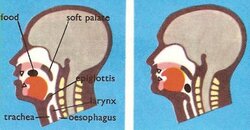You actually have to close off your Soft Palate, which is the passageway between your nose and throat. This will keep you from inhaling water down your nose. Closing the Soft Palate will effectively make your only airway through your mouth.
The Epiglottis is the valve in your throat that is responsible for holding your breath. Often times, people naturally make the habit of linking these two valves in their voluntary muscle movements. Kinda like people who can't raise one eyebrow independently.
There's a technique to gain independent control of each.
Cover your mouth with your hand and breath out only through your mouth. Your cheeks should puff up and you should not have any air coming from your nose. Release your hand and without pause, air should escape from your mouth.
Repeat this but now swap to your nose. You should feel a jolt behind your uvula, the dangly thing in the back of your throat. If there's no jolt, then you held your breath before making the swap. (meaning you stopped and simultaneously opened both your soft palate and epiglottis).
You're looking for that jolt.
Go back and swap between releasing from your mouth and nose. Speed up as you get the hang of it and eventually you should be able independently control each. You can then apply that for when you take off your mask.
The Epiglottis is the valve in your throat that is responsible for holding your breath. Often times, people naturally make the habit of linking these two valves in their voluntary muscle movements. Kinda like people who can't raise one eyebrow independently.
There's a technique to gain independent control of each.
Cover your mouth with your hand and breath out only through your mouth. Your cheeks should puff up and you should not have any air coming from your nose. Release your hand and without pause, air should escape from your mouth.
Repeat this but now swap to your nose. You should feel a jolt behind your uvula, the dangly thing in the back of your throat. If there's no jolt, then you held your breath before making the swap. (meaning you stopped and simultaneously opened both your soft palate and epiglottis).
You're looking for that jolt.
Go back and swap between releasing from your mouth and nose. Speed up as you get the hang of it and eventually you should be able independently control each. You can then apply that for when you take off your mask.






